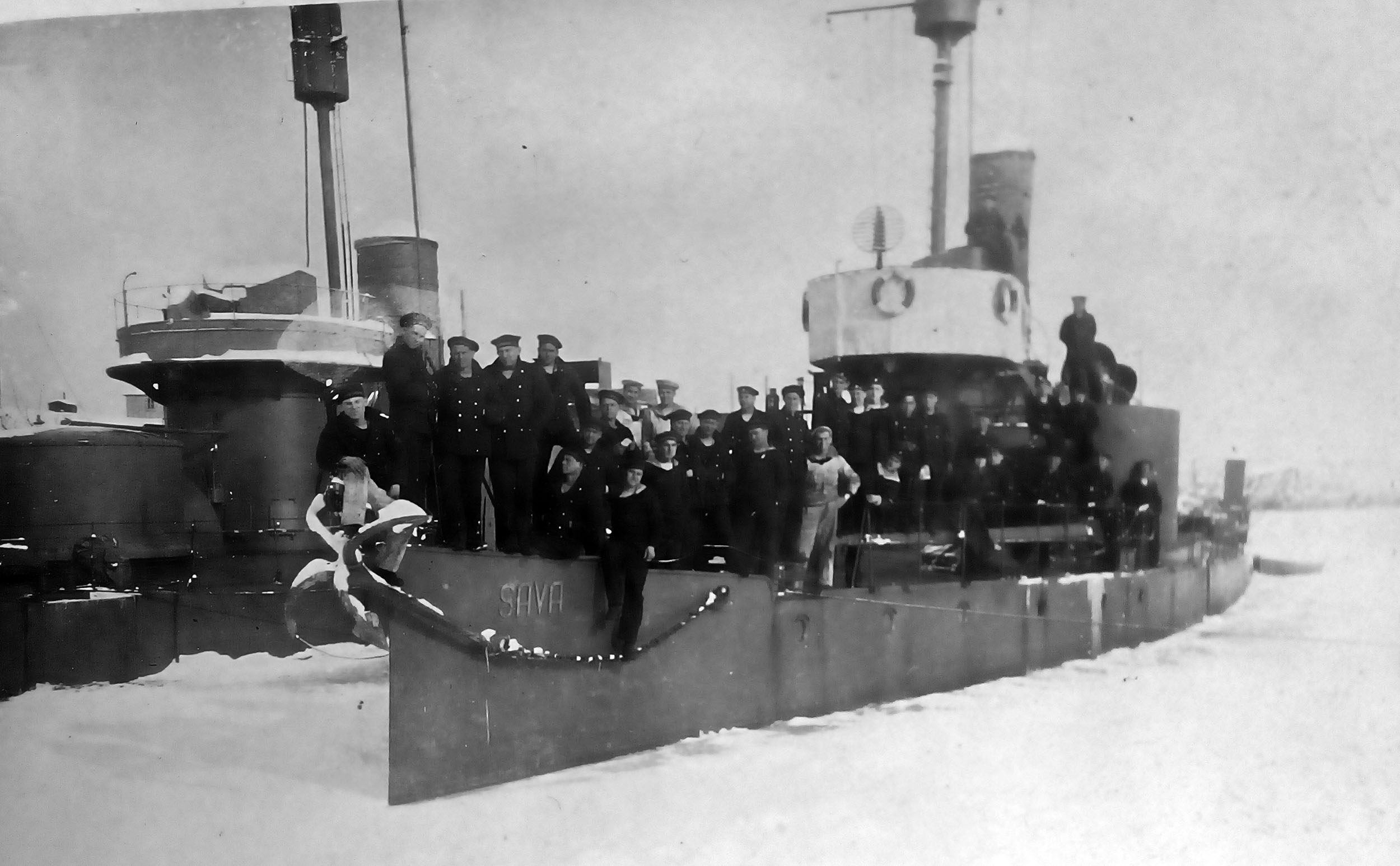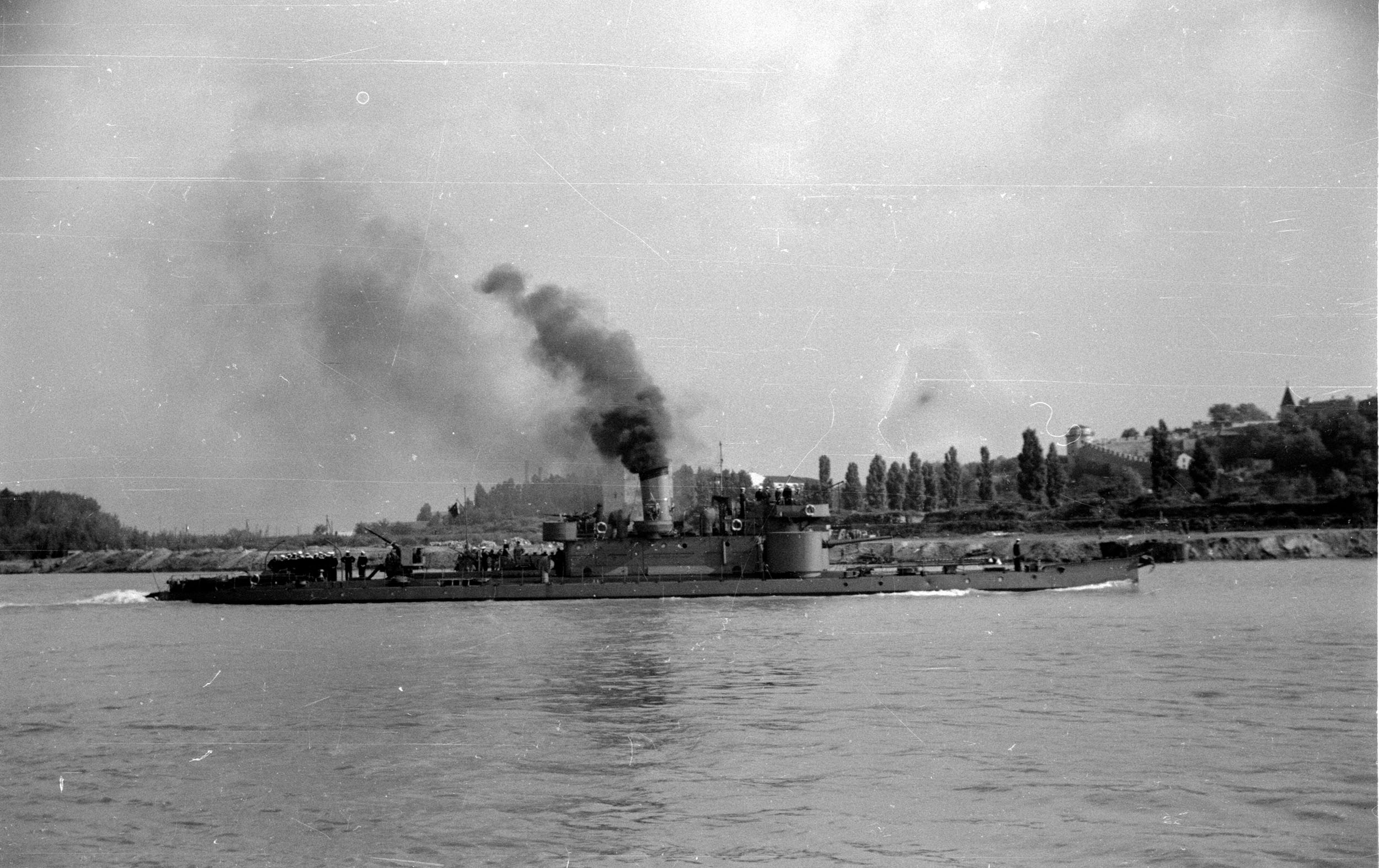River Мonitor "Sava"
The river warship, that is, the Bodrog monitor, was built in 1904 at the Danubius-Schoenichen & Hartmann AG shipyard in Budapest, together with an identical ship named Temes. The monitors were made according to the plan of the shipbuilder - chief engineer Jozef Til.The length of the monitor is 56.2 m, width 9.86 m, maximum height 12.8 m, side height 2.2 m, weight 440 t. (displacement), draft 1.2 m, displacement 442.47/484.81 t. Driven by 2 Schichau boilers (coal fired), 2 axles, 3-cylinder V.T.E. 1400 hp. Its average sailing speed is 13 knots. In 1904, it was armed with 2 12 cm cannons, 2 37 mm machine guns and a 12 cm howitzer. It is armored with a belt of 40 mm, towers with 75 mm, deck with 25 mm. The original crew consisted of 77 people.
These two monitors had their first test voyage already on August 2, 1904. It was introduced into the Austro-Hungarian Danube Military Flotilla in 1905. In peacetime conditions, it was used to control traffic on rivers and transport infantry. In July 1914, he was assigned to Zemun.
On the Danube, with a base in Zemun, were stationed the 1st Monitor Group (1 Monitorgruppe) consisting of the command ship Temes (SMS Temes), the monitor Bodrog (SMS Bodrog) and patrol boats (Patrouilenboot) b and f as well as the 2nd Monitor Group (2 Monitorgruppe) - monitors Samoš (Szamos) and Kereš (SMS Körös) and the patrol boat s.
The base of the patrol boats (patrol boats d and g) was located in Pančevo (Patrouillenbootsstation Pancsova). On the Sava, with a base in Brčko, operated a Monitor Group (Monitorgruppe) made up of the old monitors Maros (Maros) and Leitha, (Leitha), patrol boat h and three auxiliary ships.
On July 28, 1914, around 10:30 p.m., the landing of the Danube flotilla on Serbia began from Zemun. Namely, the Austro-Hungarian tugs In (DDSG Inn), then Jozef (DDSG József), Ferti (DDSG Fertő) and Sovacige (DDSG Szötségé), which were towing barges with Austro-Hungarian soldiers, tried to break into the Sava and invade Belgrade. In the absence of a river war flotilla, Serbia was unable to provide an adequate response to the Austro-Hungarian operations along the Sava and Danube rivers. Thus, Serbian forces were limited to action from the land. The intensification of infantry fire was the signal for Captain Alic to electrically activate the explosive placed on the steel structure of the first arm of the railway bridge. At 1:30 a.m., 16/29. July, a terrible explosion reverberated through the city. When the smoke cleared, it was seen that the arm, severed at the first pylon, rested on the coastal embankment. The destruction of the bridge forced the Austro-Hungarian ships to retreat. The command monitor Temeš sailed to help them, and opened fire on the barracks in the Lower Town of the Belgrade fortress from the Škoda 12cm/L35 cannon. Those were the first shells that fell on Belgrade. Immediately after opening fire from the command monitor, the shelling of Belgrade continued with three more monitors Bodrog, Samoš and Keres.
During 1914 and 1915, the monitor Bodrog participated in the shelling in support of the attacks on Belgrade. After the conquest of Belgrade, together with other units of the Danube Flotilla, in the continuation of the war, the monitor was engaged on the lower Danube.
Sailing upstream on the Danube, on October 31, 1918, the monitor Bodrog ran aground in the fog in the shallows near Vinča. The tugboats that came to his aid to pull him out were sunk by Serbian artillery, and Bodrog was captured as war booty.
Аfter the Great War, in 1920, the Bodrog monitor was officially assigned to the SHS Kingdom and became part of its flotilla under the changed name of Sava. The monitor was reconstructed for the first time in 1932 in the Sartid shipyard in Smederevo. Until the beginning of World War II, he performed peacetime duties on the Danube. After the outbreak of the Second World War, by blocking the Sip Canal, it made navigation on the Danube impossible. In order not to fall into the hands of the Germans, on the night between April 11 and 12, along the left bank of the Sava River, near its confluence with the Danube, it was sunk by its own crew. He was laid across, his stern resting on the shallow bank, while his bow dived towards the deep river bed. When the water level dropped, the monitor came out of the water with one third of its length at the stern. The NDH Navy took it out in 1942, repaired it and used it for its own purposes, also under the name Sava. Towards the end of the war, on the night between September 8 and 9, 1944, near Slavonski Brod, the RM NDH crew sank it again.
After the end of the war, the ship was soon taken out, repaired, re-armed and included in the composition of the Yugoslav River War Flotilla. The Sava monitor was part of it until 1959, when it was taken out of service, and in 1963 it was deleted from the list of effective ships. Since that year, the ship has been owned by the company Hero Pinki, and since the privatization of this state-owned company, it has belonged to the company Dunav Grupa Aggregati from Novi Sad, where it served as a wharf alongside the Tisa dredger on Ada Huja.
By decision of the Museum of Science and Technology no. 234/1 of 13.12.2005. In 2015, the ship was declared a cultural asset, and in October 2015, the Ministry of Defense purchased the ship and handed it over to the Military Museum for safekeeping.
The Sava River Monitor, part of the Military Museum's Exterior Collection, is open to visitors who can tour the permanent exhibition and learn many details about the duration of this, in our area, unique object.
The Sava River Monitor is open for visitors every day except Monday from 10:00 a.m. to 5:00 p.m. (last ticket sale at 4:00 p.m.) in the period April-October.
In case of bad weather conditions (rain, wind), the monitor is closed to visitors for safety reasons.
Location: RM Sava is moored at Belgrade's Sava Pier, on the right bank of the Sava River, downstream from the Branko bridge.
On the Danube, with a base in Zemun, were stationed the 1st Monitor Group (1 Monitorgruppe) consisting of the command ship Temes (SMS Temes), the monitor Bodrog (SMS Bodrog) and patrol boats (Patrouilenboot) b and f as well as the 2nd Monitor Group (2 Monitorgruppe) - monitors Samoš (Szamos) and Kereš (SMS Körös) and the patrol boat s.
The base of the patrol boats (patrol boats d and g) was located in Pančevo (Patrouillenbootsstation Pancsova). On the Sava, with a base in Brčko, operated a Monitor Group (Monitorgruppe) made up of the old monitors Maros (Maros) and Leitha, (Leitha), patrol boat h and three auxiliary ships.
On July 28, 1914, around 10:30 p.m., the landing of the Danube flotilla on Serbia began from Zemun. Namely, the Austro-Hungarian tugs In (DDSG Inn), then Jozef (DDSG József), Ferti (DDSG Fertő) and Sovacige (DDSG Szötségé), which were towing barges with Austro-Hungarian soldiers, tried to break into the Sava and invade Belgrade. In the absence of a river war flotilla, Serbia was unable to provide an adequate response to the Austro-Hungarian operations along the Sava and Danube rivers. Thus, Serbian forces were limited to action from the land. The intensification of infantry fire was the signal for Captain Alic to electrically activate the explosive placed on the steel structure of the first arm of the railway bridge. At 1:30 a.m., 16/29. July, a terrible explosion reverberated through the city. When the smoke cleared, it was seen that the arm, severed at the first pylon, rested on the coastal embankment. The destruction of the bridge forced the Austro-Hungarian ships to retreat. The command monitor Temeš sailed to help them, and opened fire on the barracks in the Lower Town of the Belgrade fortress from the Škoda 12cm/L35 cannon. Those were the first shells that fell on Belgrade. Immediately after opening fire from the command monitor, the shelling of Belgrade continued with three more monitors Bodrog, Samoš and Keres.
During 1914 and 1915, the monitor Bodrog participated in the shelling in support of the attacks on Belgrade. After the conquest of Belgrade, together with other units of the Danube Flotilla, in the continuation of the war, the monitor was engaged on the lower Danube.
Sailing upstream on the Danube, on October 31, 1918, the monitor Bodrog ran aground in the fog in the shallows near Vinča. The tugboats that came to his aid to pull him out were sunk by Serbian artillery, and Bodrog was captured as war booty.
Аfter the Great War, in 1920, the Bodrog monitor was officially assigned to the SHS Kingdom and became part of its flotilla under the changed name of Sava. The monitor was reconstructed for the first time in 1932 in the Sartid shipyard in Smederevo. Until the beginning of World War II, he performed peacetime duties on the Danube. After the outbreak of the Second World War, by blocking the Sip Canal, it made navigation on the Danube impossible. In order not to fall into the hands of the Germans, on the night between April 11 and 12, along the left bank of the Sava River, near its confluence with the Danube, it was sunk by its own crew. He was laid across, his stern resting on the shallow bank, while his bow dived towards the deep river bed. When the water level dropped, the monitor came out of the water with one third of its length at the stern. The NDH Navy took it out in 1942, repaired it and used it for its own purposes, also under the name Sava. Towards the end of the war, on the night between September 8 and 9, 1944, near Slavonski Brod, the RM NDH crew sank it again.
After the end of the war, the ship was soon taken out, repaired, re-armed and included in the composition of the Yugoslav River War Flotilla. The Sava monitor was part of it until 1959, when it was taken out of service, and in 1963 it was deleted from the list of effective ships. Since that year, the ship has been owned by the company Hero Pinki, and since the privatization of this state-owned company, it has belonged to the company Dunav Grupa Aggregati from Novi Sad, where it served as a wharf alongside the Tisa dredger on Ada Huja.
By decision of the Museum of Science and Technology no. 234/1 of 13.12.2005. In 2015, the ship was declared a cultural asset, and in October 2015, the Ministry of Defense purchased the ship and handed it over to the Military Museum for safekeeping.
The Sava River Monitor, part of the Military Museum's Exterior Collection, is open to visitors who can tour the permanent exhibition and learn many details about the duration of this, in our area, unique object.
The Sava River Monitor is open for visitors every day except Monday from 10:00 a.m. to 5:00 p.m. (last ticket sale at 4:00 p.m.) in the period April-October.
In case of bad weather conditions (rain, wind), the monitor is closed to visitors for safety reasons.
Location: RM Sava is moored at Belgrade's Sava Pier, on the right bank of the Sava River, downstream from the Branko bridge.
 PHOTO
PHOTO



